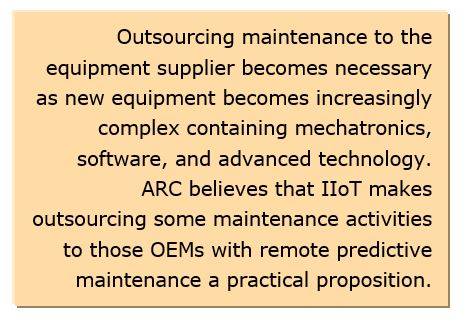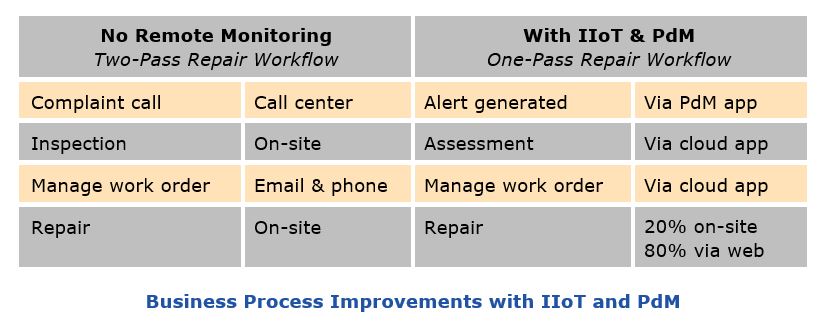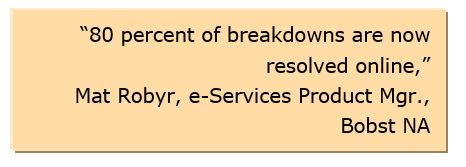

The increasing sophistication of today’s advanced industrial equipment often exceeds the capabilities of on-site, 
One solution is to outsource some maintenance activities for sophisticated assets to the OEM using Industrial IoT (IIoT) to remotely monitor the health of the equipment. The combination of remote monitoring and analytics with predictive maintenance (PdM) by experts who know the equipment best can provide significant business benefits.
Equipment complexity is increasing across two major dimensions:
Keeping up with changes in technology and automation is a challenge. New equipment for replacements or plant upgrades often have complex systems with mechanical, electrical, electronics, and software components. This technical intricacy has been building for a decade or more. In most plants today, a significant portion of the critical assets reflect a high degree of technical sophistication, making problem isolation and identification increasingly difficult. This change has been gradual over an extended period of time and many have not recognized that the old approach to managing maintenance has become unsustainable.
Each craft focuses on their skill set which is their strength and the basis for their employment. When isolating a problem, a mechanic tends to focus on the mechanical aspects and will often make a “repair” in one or more mechanical components that is really a symptom rather than the root cause. Similarly, an electrician focuses on electrical components. While several people with different crafts could be assigned to a single work order, this approach significantly reduces productivity.
With today’s sophisticated systems, the traditional dedicated craft approach to maintenance is becoming unsustainable since it is often not very effective at identifying the root cause of an issue, much less rectifying it.
A systems approach - where the technician has skills across multiple crafts - provides an improvement for supporting more modern equipment. The goal has the technician accessing mechanical, electronics, and software to be able to isolate and identify problems. For complex equipment, this multi-talent approach provides an improvement over specific crafts. Unfortunately, the viability this systems approach is impacted by these issues:
For a particular type of equipment, deep and expensive training ages quickly and has a short shelf life – usually a few months at best. Unless the technician engages those skills on a daily basis, the knowledge decays. Also, the good technicians who can absorb the training are the ones most likely to move onto another job through promotion or otherwise. The pace of technology change continues to increase, and this equipment complexity issue will only get worse.
IIoT and analytics open the door to outsourcing maintenance of complex equipment – even critical equipment – to the OEM that typically has deep knowledge and understanding of the equipment it designed and built. Many suppliers of complex equipment have started to offer aftermarket services for asset health monitoring, PdM and maintenance. In many cases, these services prevent failures before they can occur.
When a customer has an equipment problem, the workflow for service and repair significantly improves with IIoT and PdM. The old method involved a complaint call with high urgency due to unplanned downtime causing production interruptions. The repair process needed two passes – one to determine the source of the problem and another to execute the repair. Getting the machine back online could take several days, which is typically unacceptable to the customer. Avoiding production interruptions and associated revenue losses provide the key reasons for having an internal maintenance staff.

PdM using IIoT and analytics via the web provides advanced warning of a pending failure, and repair is planned ahead to minimize production interruptions. An added benefit is that, often, the repair occurs via the web. At the ARC I
With predictive maintenance, technicians can perform work at the optimum time. Compared to preventive maintenance, a study by Shell shows that PdM reduces maintenance costs by half. The Plant Engineer’s Handbook mentions the following benefits for PdM:
The business impact of lower unplanned downtime has immediate benefits like increased capacity and revenue. Secondary benefits include lower inventory (less safety stock for unplanned events) and improved customer satisfaction (with higher on-time shipments).
Predictive maintenance services provided by the OEM using IIoT and analytics provides a means to mitigate the challenge of supporting new, technically complex equipment while also reducing costs. ARC has the following recommendations:
If you would like to buy this report or obtain information about how to become a client, please Contact Us
Keywords: Maintenance Management, IIoT, Predictive Maintenance, PdM, ARC Advisory Group.

